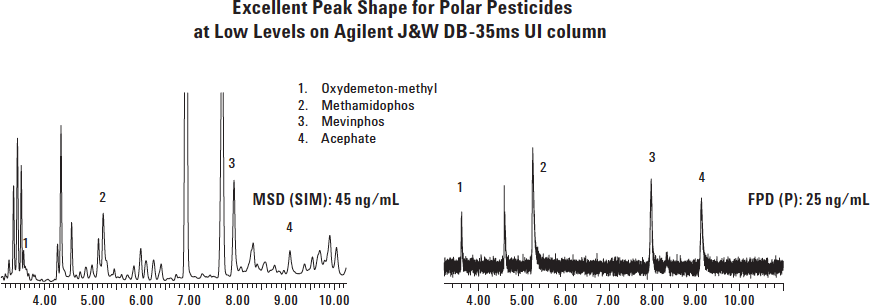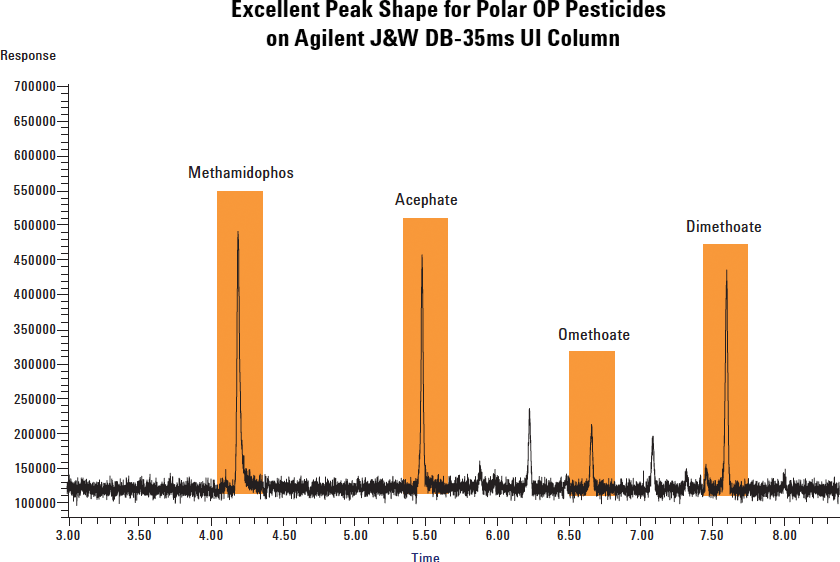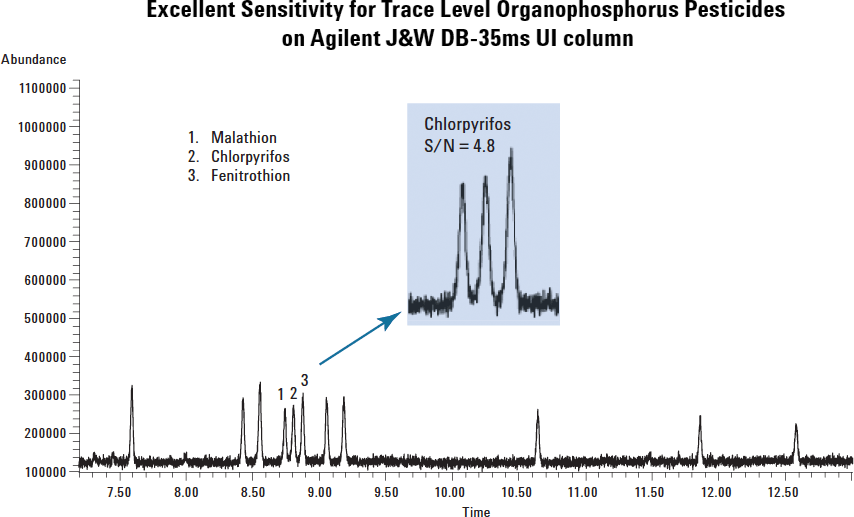Access Agilent eNewsletter May 2016

Quick, accurate pesticide analysis in foods using Agilent J&W DB-35ms Ultra Inert GC columns
Laura Provoost
Agilent GC Columns Product Manager
Kenneth Lynam
Agilent Application Chemist
As the world population has grown, so has the use of pesticides to protect crops and increase crop yields. Organophosphorous (OP) pesticides are a commonly used class of insecticides. These pesticides affect the nervous system of insects and animals by inhibiting the enzyme acetylcholine esterase, which is important in helping regulate nerve impulses.
Human toxicities for this class of OP pesticides have shown acute as well as chronic effects from pesticide poisoning. Children are considered to be more susceptible to organophosphate toxicity because their pesticide dose per body weight is larger compared to that of adults. Children also have lower levels of detoxifying enzymes that deactivate OP pesticides, further contributing to their vulnerability to pesticide exposure. The primary source of exposure to OP pesticides is through the consumption of food containing OP residues. Therefore, analytical testing capable of determining residual pesticide levels in food samples is critical.
Improved peak shapes for active organophosphorous pesticides
Gas chromatography (GC) analysis of OP pesticides is challenging. These chromatographically active compounds can adsorb onto active sites in the sample flow path, particularly at trace levels, compromising analyte response. OP pesticides tend to show peak tailing due to interactions with active sites in a chromatographic system. Also, to minimize their accumulation in the environment, many pesticides are intentionally designed to decompose easily. These include OP pesticides, which degrade rapidly by hydrolysis. This unwanted degradation or adsorption of OP pesticides during analysis can result in inaccurate quantitative results, qualitative results, or both.

Figure 1. Enlarged section of GC/MS and FPD chromatograms of the more polar pesticides analyzed on an Agilent J&W DB-35ms UI capillary column.

Figure 2. An enlarged section of a GC/FPD chromatogram of a 15 ng/mL in olive oil extract pesticide standard with the analyte protectant, gulonolactone, analyzed on an Agilent J&W DB-35ms UI capillary column.

Figure 3. Enlarged section of a GC/FPD chromatogram of a 10 ng/mL in olive oil extract pesticide standard with the analyte protectant, gulonolactone, analyzed on an Agilent J&W DB-35ms UI capillary column.
To demonstrate the critical need for accurate pesticides analysis, the following study is used. The levels of OP pesticide residues in apple extracts were determined by GC/MS/FPD. OP pesticides were resolved on an Agilent J&W DB-35ms UI 20 m x 0.18 mm, 0.18 µm column in about 30 minutes. Figure 1 depicts an enlarged section of the GC/MS in Select Ion Monitoring (SIM) mode and FPD chromatograms. It shows the excellent peak shape achieved for four of the more polar OP pesticides (Oxydemeton-methyl, methamidophos, mevinphos, acephate). The excellent peak shapes achieved with the Ultra Inert column allow for more reliable quantitation at low levels. In this study, OP pesticides were detected at levels well below the US maximum residue levels (MRLs) in the apple matrix.
In another example, 16 OP pesticides in olive oil were resolved in less than 16 minutes using an Agilent J&W DB-35ms UI 30 m x 0.25 mm, 0.25 µm column. On average, 4 kg of olives are needed to produce 1 kg of olive oil. This results in concentrated levels of residual pesticides in olive oil, so it is essential to be able to accurately measure the levels of OP pesticide residues in olive oil. Figure 2 shows a section of a GC/FPD chromatogram of the polar OP pesticides, Methamidophos, Acephate, Omethoate and Dimethoate, at 15 ng/mL in olive oil extracts.
These pesticides are known to be challenging to analyze by GC, as they all contain a P = O bond. This bond has the potential for forming hydrogen bonds making them more susceptible to matrix-induced effects. However, as shown in Figure 2, excellent peak shapes were achieved for these compounds using the Agilent J&W DB-35ms UI column. Low levels of OP pesticides in complex matrices, such as olive oil, can be detected using Flame Photometric Detection (FPD) in phosphorous mode, which is selective for analytes containing phosphorous. High signal-to-noise ratios, such as those shown in the analyses of chlorpyrifos at 10 ng/mL in Figure 3, indicate a high level of sensitivity. Using this method, the presence of OP pesticides could be detected down to low ppm and trace levels in olive oil extracts.
These results demonstrate that the Agilent J&W DB-35ms Ultra Inert columns are useful for high sensitivity analyses of organophosphorous pesticides in complex food matrixes.
Flow path inertness plays a critical role in the accuracy and precision of pesticide analyses. The Agilent Ultra Inert capillary GC columns, such as the Agilent J&W DB-35ms Ultra Inert (UI) column, minimize column activity and allow difficult active analytes to be consistently analyzed at trace levels. The use of the midpolarity DB-35ms UI phase offers extra selectivity over a nonpolar phase. This can help in resolving potentially co-eluting peaks, or shift a peak of interest away from matrix interferences.
Agilent J&W DB-35ms UI column performance for the analysis of difficult polar OP pesticides in food matrixes is illustrated in Agilent application notes 5990-7165EN and 5990-7722EN.
Sensitive analyses with Agilent J&W Ultra Inert columns
The Agilent Ultra Inert capillary columns significantly improve results by providing higher response, better peak shape, better calibration linearity, and consistency. These positive outcomes demonstrate that minimization of column active sites is critical to achieve accurate, precise, and reliable results for pesticide residue analyses. If you need the best possible results, see how Agilent Ultra Inert capillary columns can improve your pesticide analysis.
Agilent offers a wide array of high-performance solutions for pesticide analysis
Agilent offers an impressive line-up of high-performance solutions for all of your pesticide analysis needs. These Agilent solutions, products, and supplies are designed to improve performance and minimize downtime in your GC and GC/MS analyses. Take a moment to check out the whole family.
Stay informed about the applications that are important to you
Subscribe to Access Agilent
Our free customized
monthly eNewsletter
All articles in this issue
 Detailed analysis of therapeutic proteins with Agilent 1290 Infinity II 2D-LC Solution
Detailed analysis of therapeutic proteins with Agilent 1290 Infinity II 2D-LC Solution Agilent AdvanceBio SEC delivers optimal performance regardless of instrument
Agilent AdvanceBio SEC delivers optimal performance regardless of instrument Quick, accurate pesticide analysis in foods using Agilent J&W DB-35ms Ultra Inert GC columns
Quick, accurate pesticide analysis in foods using Agilent J&W DB-35ms Ultra Inert GC columns Agilent Mini-QuEChERS and HES provide robustness and cost-savings in GC/MS/MS pesticide analysis of foods
Agilent Mini-QuEChERS and HES provide robustness and cost-savings in GC/MS/MS pesticide analysis of foods Agilent OpenLAB Electronic Lab Notebook gives biopharma company a competitive edge
Agilent OpenLAB Electronic Lab Notebook gives biopharma company a competitive edge Improved efficiency in routine analysis of hydride and non-hydride elements using Agilent MSIS
Improved efficiency in routine analysis of hydride and non-hydride elements using Agilent MSIS Maximize lab productivity and results consistency with Agilent SQ Walkup Solution
Maximize lab productivity and results consistency with Agilent SQ Walkup Solution Agilent Automated Purification Solutions help researchers to purify complex compounds
Agilent Automated Purification Solutions help researchers to purify complex compounds
Figure 1

Enlarged section of GC/MS and FPD chromatograms of the more polar pesticides analyzed on an Agilent J&W DB-35ms UI capillary column.
Figure 2

An enlarged section of a GC/FPD chromatogram of a 15 ng/mL in olive oil extract pesticide standard with the analyte protectant, gulonolactone, analyzed on an Agilent J&W DB-35ms UI capillary column.
Figure 3

Enlarged section of a GC/FPD chromatogram of a 10 ng/mL in olive oil extract pesticide standard with the analyte protectant, gulonolactone, analyzed on an Agilent J&W DB-35ms UI capillary column.